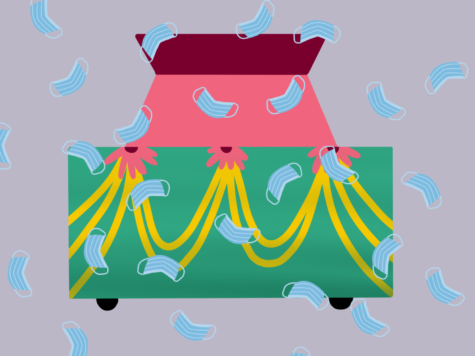OPINION | What we haven’t learned about mask mandates
March 16, 2022

When the Tulane University community received the email notifying that the mask mandate would be lifted the week after the first Mardi Gras in two years, some were wary.
There was no way that after the biggest party that the city of New Orleans hosts, where the city welcomes 1.4 million additional tourists, that city officials would make the executive decision that this was the best time to lift the mask mandate.
Carnival is often a breeding ground for germs, as lowered inhibitions prevent people from being as cautious as they normally would be about their health and safety. In fact, the initial spike in COVID-19 cases that rocketed the city into quarantine was Mardi Gras 2020, which spawned up to 50,000 cases.
A study that sought to pinpoint where COVID-19 outbreaks seemed to stem from in different parts of the United States said “that 2020 Carnival revelry was responsible for tens of thousands of coronavirus cases, after a single person likely brought it to New Orleans in the weeks before Mardi Gras.”
Knowing this, why would the city think lifting the mask mandate would be a reasonable course of action?
According to Mayor LaToya Cantrell’s statement when the indoor mask mandate was lifted, “for several weeks, COVID-19 cases, hospitalizations and deaths drastically decreased due to the city’s more stringent mitigation measures, strong vaccine rates and proof of vaccination or negative test requirements for most indoor spaces and other facilities previously implemented.”
The statement also highlights that, because of the “sacrifices” of business owners and residents, the city has demonstrated that it is once again capable of holding large-scale entertainment events like Carnival.
In 2021, the city completely canceled Mardi Gras because of the virus. Instead of following this course of action, Mardi Gras went on as planned this year, despite rising cases due to the omicron variant.
One of the reasons cited for the lifting of the mask mandate was the low case count. But how many residents were getting tested while partying on the parade route? According to the Louisiana COVID-19 tracking dashboard, the weekend following the highly anticipated Krewe of Muses parade, the amount of tests the city received were much lower than usual leading up to Fat Tuesday on March 1.
New Orleans has been a hot spot for the COVID-19 virus since the pandemic started to spread in the U.S. Despite the city being a hot bed for the virus, it seems we will continue to make the same mistakes.
In fact, Mardi Gras almost always coincides with flu season, the illness’ peak months falling between December and February and sometimes continuing into May.
However, despite the fact that masks have been proven to not only slow the spread of the COVID-19 but also keep an individual from getting sick over the past two years, some still may choose not to wear a mask at all.
While the mask mandate being lifted does not seem like the best course of action considering the history of cases in the city, the decision is not an order for everyone to stop wearing a mask — it is still a choice.
Immunocompromised people, or peers that are frequently around immunocompromised individuals, might still opt to wear a mask for their safety and the safety of others.
Many healthcare workers can still be seen wearing their masks, despite the number of vaccines they have received, as they frequently deal with patients who do have COVID-19 or may have it. Students and professors around campus can also still be seen masking, as it may be a safer choice for them.
Peter Kunze, a professor in the communication department, expressed he appreciated the mask mandate because it not only seemed the best practice but also “created a sense of solidarity and commitment to doing what we can to stem the increasing prevalence of this virus in our community and in our city.”
Some professors, such as Kunze, make the choice to continue masking in class for their students and for themselves.
Not wanting to mask is understandable — the world wants to return to a sense of normalcy where you can see someone’s face in public when you meet them or grab lunch with an old friend without fearing you’re infecting them or they’re infecting you. And that is completely valid.
“I was a bit wary to see [the mask mandate] suspended so soon after Mardi Gras,” Kunze said, “but I trusted that it was done in the best interest and with the best knowledge.”
Numbers, fortunately, have continued to stay low even after the Carnival season. While lifting the mask mandate right after Carnival season may not have been the best idea, the city is honoring their promise to stay vigilant in lieu of the ever changing reality of the pandemic.
Correction: A previous version of this article included a broken link which has since been updated to reflect accurate information.






















RK • Mar 18, 2022 at 1:12 pm
More stupidity of opinion from someone obviously enamored with Lord Mengele Fauci. The masks never did a thing, could not be worn effectively 24/7, and the vaccines proved they did not stop infection or transmission. WAKE UP people!!!